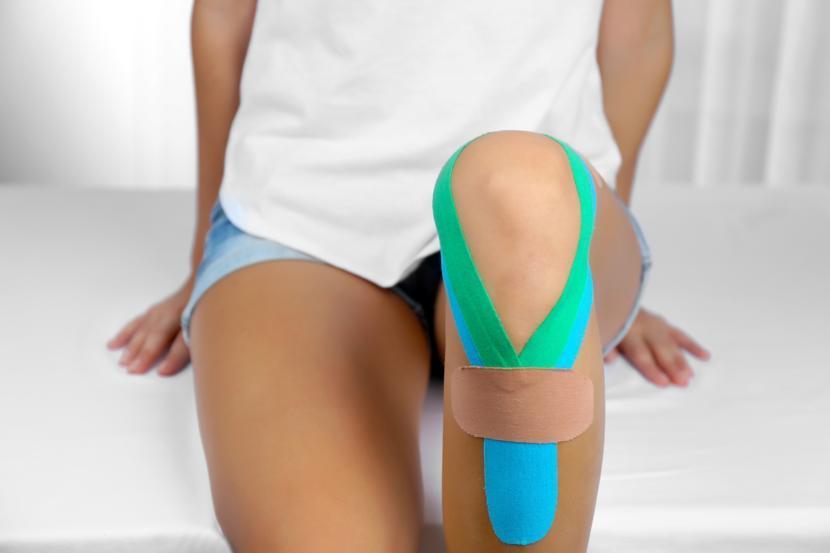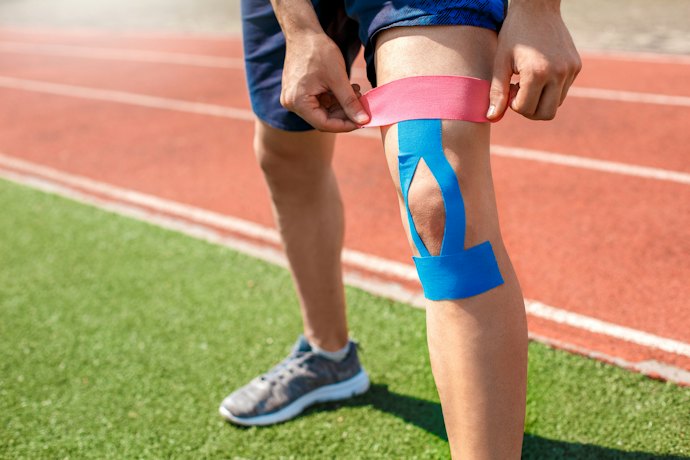Kinesiology tape, designed to mimic the skin’s elasticity, adheres to the human skin to gently pull and lift the skin. Professional athletes and healthcare professionals alike use this innovative approach in sports medicine to treat injuries like rotator cuff tears, plantar fasciitis, and tennis elbow. Its application over muscles and joints helps to lessen pain, facilitate increased circulation, and support proper posture while allowing motion. Notably, it aids in decreasing shoulder pain, mitigating Achilles tendonitis, and minimizing skin irritation without causing skin damage.
Introduction to Kinesiology Tape
Composed of a cotton blend, kinesiology tape adheres to the skin as an elastic therapeutic tape that provides support and relief. It’s latex-free and hypoallergenic, making it suitable for a broad range of users seeking a non-invasive method to relieve pain and enhance movement during their physical activities.
Origins and Evolution of Kinesiology Taping
Kinesiology taping has emerged as a revolutionary method of addressing joint pain and has evolved significantly since its inception. Its development reflects a growing understanding of the body’s natural healing processes and the role that supportive taping can play in enhancing them.
Defining Kinesiology Tape and Its Common Uses
The cotton blend of kinesiology tape adheres to the skin, providing a latex-free and hypoallergenic option to support the body’s musculoskeletal system. Its uses range from managing sports injuries to improving posture and reducing the strain on overused muscles.
The Mechanics of Kinesiology Tape
Kinesiology tape operates under tactile feedback, offering muscle support and influencing the lymphatic and circulatory systems to promote healing and performance.
Tactile Feedback and Muscle Support
The tape’s unique design provides tactile feedback that can help improve proprioception and the body’s ability to sense its position in space. This feedback helps to stabilize and support muscles and joints without restricting the range of motion, which is crucial for athletes and individuals recovering from injuries.

Elevation of the Skin and Reduced Pressure on Underlying Tissues
Lifting the skin, kinesiology tape reduces pressure on underlying tissues, leading to decreased pain and inflammation in the affected areas.
Creating Space in Joints
Applying kinesiology tape around joints can create space, reducing compression and allowing for a more pain-free range of motion. This space can also contribute to better joint function and a decreased likelihood of injury exacerbation.
Impact on Blood Flow and Lymphatic Drainage
Kinesiology tape can positively impact blood flow and lymphatic drainage, reducing swelling and inflammation. This is particularly beneficial in sports physical therapy, where managing swelling is crucial for a swift recovery.
Kinesiology Tape in Action
When applied skillfully, kinesiology tape becomes an active player in treating musculoskeletal injuries, from the acute phase through recovery.
Athletic Tape vs KT Tape: Comparing Uses in Sports
While traditional athletic tape restricts movement to prevent injury, kinesiology tape, or KT Tape, lifts the skin to facilitate healing and treat injuries such as rotator cuff issues, plantar fasciitis, and tennis elbow. Its elastic nature supports the healing process of Achilles tendonitis and can alleviate neck pain. A healthcare professional can guide you on applying and removing the tape to maximize benefits and prevent skin irritation.
From Injury Recovery to Performance Enhancement
Kinesiology tape plays a versatile role in aiding injury recovery and enhancing performance by supporting muscles during activity.
Treating Injuries
When treating injuries, kinesiology tape is an ally, offering support and relief to distressed areas and promoting the body’s natural healing process.
Re-Educating Muscles for Optimal Movement
Kinesiology tape can also be used to re-educate muscles for optimal movement patterns, which can help prevent future injuries and improve overall performance.
Evaluating the Effectiveness of Kinesiology Tape
The effectiveness of kinesiology tape is a topic of ongoing research, with studies exploring its impact on injury rehabilitation and athletic performance enhancement.
Published Research Findings
Studies investigating the efficacy of kinesiology tape often yield mixed results. For instance, research on knee pain indicates that while some patients report symptomatic relief, objective improvements in function are less clear. The tape’s ability to alleviate pain may stem from neuromuscular mechanisms rather than structural support, suggesting a complex interplay between the body’s sensory systems and the tape’s applications.
Testimonies and Case Studies
Anecdotal evidence and case studies from clinicians and patients often highlight positive outcomes, particularly praising the tape’s role in managing pain and improving mobility.
Kinesiology Tape for Injury Rehabilitation
Kinesiology tape is increasingly popular in injury rehabilitation, with many users experiencing pain relief when applied over affected areas. Its elastic properties are believed to lift the skin, reduce pressure on injured tissues, and facilitate a healing environment, which may accelerate recovery.
Kinesiology Tape for Sports Performance
Athletes across various sports utilize kinesiology tape for its potential to enhance performance. While evidence is inconclusive, some report improved muscle endurance and proprioception, which may contribute to better athletic execution and reduced risk of injury.
Practical Insights for Kinesiology Tape Users
Understanding the correct use of kinesiology tape can maximize its benefits and minimize potential skin irritation or other adverse effects.
Guidelines for Duration and Frequency of Usage
Kinesiology tape is generally safe for multiple wear days, often three to five days. Users are advised to monitor their skin’s response and adhere to manufacturer guidelines regarding duration and frequency to avoid overuse and skin irritation.
Can Kinesiology Tape Be Self-Applied?
With proper guidance and technique, individuals can self-apply kinesiology tape to address their specific needs.
How to Apply Kinesiology Tape Correctly
For effective application, ensure the skin is clean and dry. Cut the tape to the desired length, round the edges to prevent peeling, and apply with the appropriate tension, usually 50-75% stretch, except for the ends, which should have no stretch to secure the tape.
Tips for Safe Removal to Protect Your Skin
To safely remove kinesiology tape, gently peel it back over itself while supporting your skin. Avoid yanking or pulling upwards to minimize skin irritation. If resistance is felt, applying oil can help loosen the adhesive for easier removal.
Potential Limitations and Considerations
While kinesiology tape offers benefits, it’s not a panacea. The tape’s effectiveness may vary based on the individual’s condition, the application method, and the body area being taped. Reliance solely on taping without comprehensive treatment can lead to inadequate care.
When Kinesiology Taping May Not Be Advisable
Kinesiology taping may not be suitable for individuals with certain conditions such as joint pain, compromised connective tissue, or impaired lymphatic fluids management. In the United States, professionals caution against using tape when the flow of lymphatic fluid is obstructed or infection is present.
Myths and Misconceptions: Separating Fact from Fiction
One common misconception is that kinesiology tape can resolve shoulder instability independently. While it may offer support and sensory feedback, it should be part of a broader treatment plan that includes strength training and physical therapy.

Integrating Kinesiology Tape Into Personal Care Routines
As you explore ways to manage your health, consider incorporating kinesiology tape into your self-care routine. Its ability to support and relieve injured muscles makes it a valuable addition, especially for those with active lifestyles. Whether dealing with an injury or seeking extra support during your fitness endeavors, kinesiology tape can be a practical, self-administered solution that complements other aspects of your health regimen.
The Future of Kinesiology Tape in Medicine and Sports
Looking ahead, the future of kinesiology tape in medicine and sports seems promising, with ongoing research into its effectiveness. For patients with patellofemoral pain syndrome and similar ailments, kinesiology taping continues to offer a non-invasive option that can enhance traditional treatments. As its use widens and understanding deepens, we can anticipate even more innovative applications that will solidify the standing of kinesiology tape in both therapeutic and athletic domains.
Pros and Cons of Kinesiology Tape
Kinesiology tape offers a range of benefits and drawbacks that should be considered before use.
Pros
- Non-invasive application.
- Supports without restricting movement.
- Potentially reduces pain.
- Facilitates lymphatic drainage to expedite healing.
Cons
- Risk of skin irritation or allergic reactions.
- Requires proper application technique for effectiveness.
- Benefits may be largely placebo-based.
- Professional consultation recommended for best results.
Conclusion
Kinesiology tape has emerged as a versatile tool in holistic care, supporting the body’s natural healing process. When integrated into a comprehensive wellness regimen, the tape complements other therapies and promotes overall physical well-being. By acknowledging the physical and psychological benefits of kinesiology tape, users can appreciate its role in maintaining and enhancing health, ensuring a place for this innovative aid in personal care routines.
